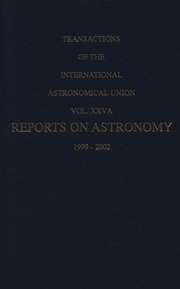No CrossRef data available.
Article contents
11. Galactic Dynamics: Stellar Orbits
Published online by Cambridge University Press: 24 November 2021
Extract
The interest in stellar orbits focussed on two areas: Firstly, on the existence of non-classical integrals of motion (“third integral”) and on the occurence of stochastic or chaotic motions in systems with two or three degrees of freedom. While the case of three degrees of freedom is the more realistic one, results on systems with only two degrees of freedom can be applied to situations such as the motions of stars in the co-moving meridional plane of axisymmetric galaxies or in the equatorial plane of spiral or barred galaxies. Secondly, there is continuing interest in the orbital motions of stars in triaxial systems, which may represent either triaxial elliptical galaxies or galactic bars. The ultimate aim of many of the studies on stellar orbits is to build self-consistent models of stellar systems on the basis of the individual orbits of the stars.
- Type
- Research Article
- Information
- Copyright
- Copyright © Kluwer 1988


